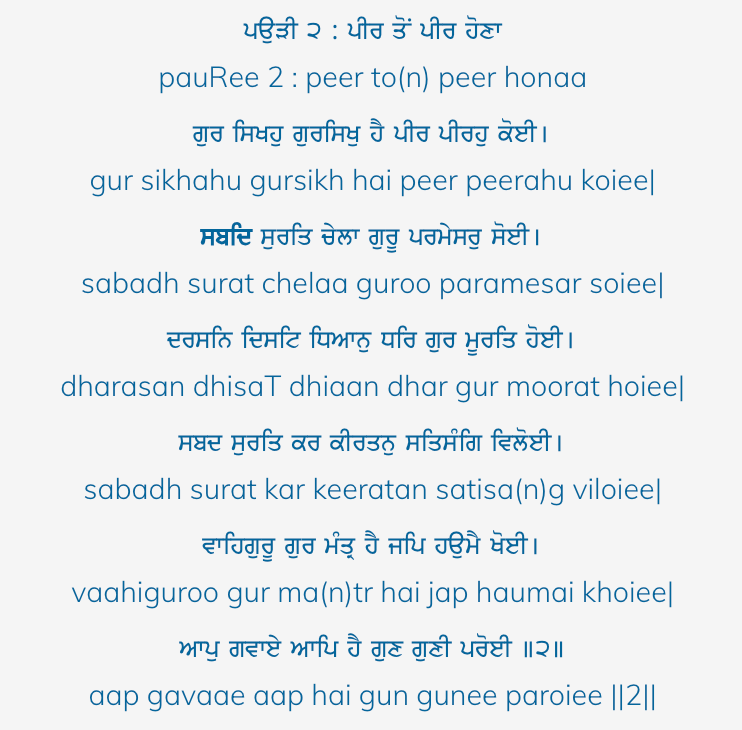Gurmantar - Transformative Wisdom Revealed (Part 2 of 2)
- Raj Palsingh

- Sep 28, 2024
- 3 min read
Updated: May 20
The transformative power of Waheguru (pronounced Va-hay-Guroo) is explained by Bhai Gurdas, a prominent Punjabi scholar in the mid to late 1500s and early 1600s who says: (*English Translation Below*)
Pauri 2: The makings of a Spiritual Guide
The one learning from the Guru is called a Gursikh some of who themselves are Spiritual Guides
That (rare) one who can truly put their consciousness in devotion to the speech sound (Shabad) experiences and attains the status of Divine Guru
The Likeness of Guru is attained through mindful concentration on the application of conduct and philosophy of Guru in one's life
Within the congregation of life minded seekers of truth, consciously do the Kirtan on the speech sound and philosophy of the Guru
Waheguru is the Gurmantra, reciting it (wholly) takes away the false sense of self
You (the divine source of life) are the source of making sing merging us into your qualities, the state beyond qualities
There is a lot to unearth to fully contemplate the above stanza from Bhai Gurdas; I'll keep it simple and work in a step by step manner. As a first step, we walk away from the stanza and then come back to examine it.
The reactive nature of the Manas, or lower mind, is the reactive nature of the mind. It is the space wherein the immediate emotions run the reaction. In this space, there is no discernment about our self. One of the truths about ourselves is that along the way somewhere we perceive this lower mind in our own voice and start believing the filters from which is perceives and interprets reality. Our lack of conscious awareness means that we accepted our reactive mind as our Master and Ruler. This part of the mind becomes a device that creates illusory realities and conclusions based upon our limited perceptive abilities. This mind fills us with stories that we react to on a moment to moment basis and makes us live our lives in an endless loop of repetition, believing the permanency of repeating it daily, weekly, monthly and annually.
Unaware of this side of the mind, we live our lives and then the reality dawns that we don't really know ourselves. This is where Mantra comes in. Mantra is the tool to work on the lower mind, or Manas. Here is the "secret" about Mantras, whether we are aware of it or not, we are always in a mantra. Our mind is constantly revolving and whirling. There is no stopping of this process, as that is the job of the mind, the mind's duty is to whirl and move and think thoughts. Just like in the universe there is no actual stillness, the mind cannot actually be still. The mind, like our body, can be refined and the tool to refine that mind is applying Mantra consciously. The effects of the unconscious mantra are our stories. In these stories, we turn ourselves into a character within a grand play in which we are the central character or lead. Unknowingly, the story makes us self-absorbed and in more extreme cases, vain and narcissistic. Within this ignorance, we allow fear to enter our psyche and through that fear we move away from love. Of what way can we retain the intelligence of the mind? In what way that we let go of ignorance and let go of the false sense of self? This is where Bhai Gurdas' stanza comes in, and here we will take a look at its meaning and introduce the Long EkOngkar to you. In the stanza of this Vaar or ballad, Bhai Gurdas is explaining the qualification of the Gurmantar and the effects of it. The very first qualification Bhai Gurdas says is that this Mantra is for one who is open to learn from the lineage of the Sikh Gurus, that the individual learning from the Sikh Gurus are called Gursikh, and that the lessons of the Gurus can even turn one into a Spiritual Guide themselves, in this qualification, Bhai Gurdas says the the one turning to a Spiritual Guide themselves is rare.
That rare one, says Bhai Gurdas is one who puts their all their efforts as a devotee towards the "Speech Sound" of the Guru, then he adds another qualifier which is that the individual can also gain the likeness of the Guru via mindful concentration, and the application of conduct within the parameters set by the philosophy of the Guru.
If we keep it really simple, chant "WaheGuru" in your mind and out loud and watch your world change. See yourself cutting through the dark with a profound source of light, one that lights up your own mind and helps your consciousness be the guide of the mind through pure energy and be the witness to the conscious change you bring into the world.




Comments